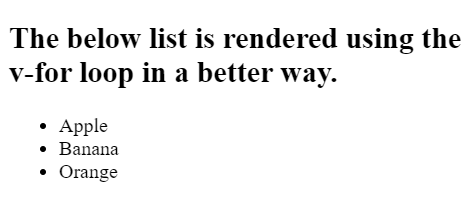Vue.js is a popular JavaScript framework used for building dynamic web applications. One of its key features is the v-for directive, which allows developers to render a list of items based on an array or an object. Writing efficient and clean v-for loops is crucial for optimizing performance and maintaining readable code.
You can utilize the below approaches to accomplish this task:
Using Key Attribute
Adding a unique key to each item in the v-for loop improves Vue's rendering performance and helps in efficiently updating the DOM.
Syntax:
<ul>
<li v-for="(item, index) in items" :key="index">
{{ item }}
</li>
</ul>
Example: The below code implements the key attribute to write better Vue v-for loops.
<template>
<div>
<h2>
The below list is rendered using the
<br />v-for loop in a better way.
</h2>
<ul>
<li v-for="(item, index) in items"
:key="index">
{{ item }}
</li>
</ul>
</div>
</template>
<script>
export default {
data() {
return {
items:
['Apple', 'Banana', 'Orange'],
};
},
};
</script>
Output:

Using Index Variable
Vue.js allows accessing the index of the current item directly within the v-for loop by passing and extra parameter to separately specify the index.
Syntax
<ul>
<li v-for="(item, index) in items">
{{ index }} - {{ item }}
</li>
</ul>
Example: The below code implements index variable to use Vue v-for loop in a better way.
<template>
<div>
<h2>
The below list is rendered using the
<br />v-for loop in a better way.
</h2>
<ul>
<li v-for="(item, index) in items">
{{ index }} - {{ item }}
</li>
</ul>
</div>
</template>
<script>
export default {
data() {
return {
items:
['Apple', 'Banana', 'Orange']
};
}
}
</script>
Output:

Using v-for with Computed Properties
Sometimes you may need to filter or manipulate the data before rendering it. Computed properties can be used in conjunction with v-for to achieve this.
Syntax:
<ul>
<li v-for="item in filteredItems">
{{ item }}
</li>
</ul>
Example: The below code will explain the use of computed properties with v-for loop to use them in a better way.
<template>
<div>
<h2>
The below list is rendered using the
<br />v-for loop in a better way.
</h2>
<ul>
<li v-for="item in filteredItems"
:key="item">
{{ item }}
</li>
</ul>
</div>
</template>
<script>
export default {
data() {
return {
items:
['Apple', 'Banana', 'Orange']
};
},
computed: {
filteredItems() {
return this.items.filter
(item => item.length > 5);
}
}
}
</script>
Output:
